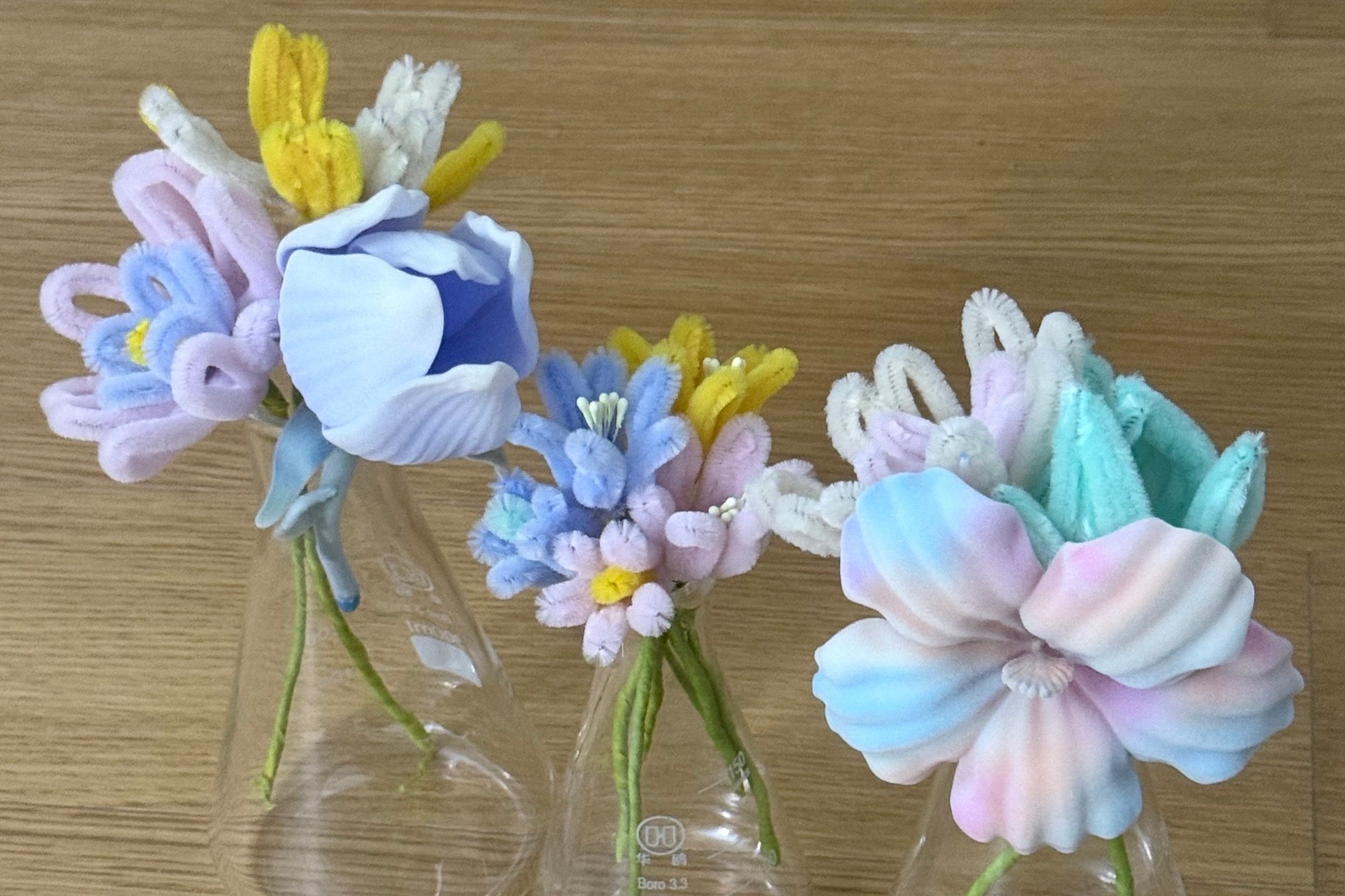FLORA LAB
NYU Integrated Design & Media Thesis
Role: Concept Designer, Researcher, Fabricator
Duration: January 2025 – May 2025

Description
Flora Lab is an interactive installation that investigates how sustainable materials—especially fragile, biofabricated ones—are perceived by the public. Combining 3D printing, traditional silk craft (Ronghua), and experimental biomaterials, the work invites viewers to touch, compare, and question what “natural” or “synthetic” truly means. Set in a lab-like environment, the installation includes static specimens, kinetic flowers, and a visual timeline of material aging. The goal is not to present sustainability as a perfected solution, but as a living, evolving process that invites curiosity, critique, and care.
Kinetic Flower
Kinetic Flower
Kinetic Flower Kinetic Flower
The kinetic flower opens slowly in response to touch, revealing its petals in a soft, radial motion. Powered by a small servo motor hidden within the base, the movement mimics the natural blooming of a real flower. The motion begins with a slight pause—then gently unfolds, creating a moment of tension and release. This blooming is not immediate, but intentionally delayed to evoke a sense of organic rhythm. The petals, made from biofabricated material, tremble slightly as they move, reinforcing their fragility.
3D Printing Flocking Flower
3D Printing Flocking Flower
3D Printing Flocking Flower 3D Printing Flocking Flower
The 3D-printed flowers in this project were inspired by the idea of creating artificial forms that blur the line between nature and fabrication. Drawing from the aesthetics of traditional botanical illustration and speculative bio-design, the flowers are digitally modeled to resemble organic curves, yet their symmetry and precision reveal their synthetic origin. Using PLA filament, each flower is printed with smooth, petal-like structures and then flocked with soft fibers to simulate the texture of natural surfaces. This treatment challenges viewers’ assumptions—what looks like cloth or plant tissue is actually plastic. The goal of these pieces is not just to mimic nature, but to provoke reflection on how material cues affect our perception of what is “real,” “organic,” or “sustainable.” By embedding artificial softness into rigid forms, the flowers embody the tension at the heart of sustainable design: the desire to feel natural, even when we’re making something new.
Traditional Handmade Flower绒花
Traditional Handmade Flower绒花
Traditional Handmade Flower绒花 Traditional Handmade Flower绒花
The handmade Ronghua flowers in this project are inspired by traditional Chinese silk flower craftsmanship, a practice that dates back more than a thousand years. As a historical craft, Ronghua is often assumed to be inherently sustainable—its association with natural silk and handmade techniques gives it an aura of authenticity and ecological harmony. However, in contemporary practice, many Ronghua are now made using synthetic fabrics and industrial dyes due to the high cost and limited accessibility of pure silk. This quiet material shift reveals a deeper tension: the aesthetic of “natural” no longer guarantees ecological responsibility. In this project, the Ronghua pieces are created using modern materials and traditional methods to highlight this contradiction. By placing them alongside biofabricated and 3D-printed flowers, the work encourages viewers to question whether sustainability lies in appearance, process, or material origin—and how tradition, too, evolves in response to modern constraints.
Bio Petal
Bio Petal
Bio Petal Bio Petal
The biofabricated petals in this project were inspired by the desire to create materials that not only look organic, but actually behave like living matter—fragile, changing, and time-dependent. Drawing from biodesign practices and natural decomposition processes, the petals are made from combinations of sodium alginate, gelatin, and natural additives such as coffee grounds and eggshell powder. Each formula was carefully tested to balance flexibility, texture, and drying time, and the results were shaped in silicone molds to mimic petal forms. Unlike synthetic or traditional materials, these petals continue to change after fabrication—curling, darkening, or cracking with time and humidity. This living quality is central to the work. The goal is not to mimic nature perfectly, but to introduce a material that invites care, curiosity, and attention. By allowing the petals to visibly age in the installation, the project positions biofabrication not as a polished solution, but as a delicate, ongoing conversation between material, time, and design.


















